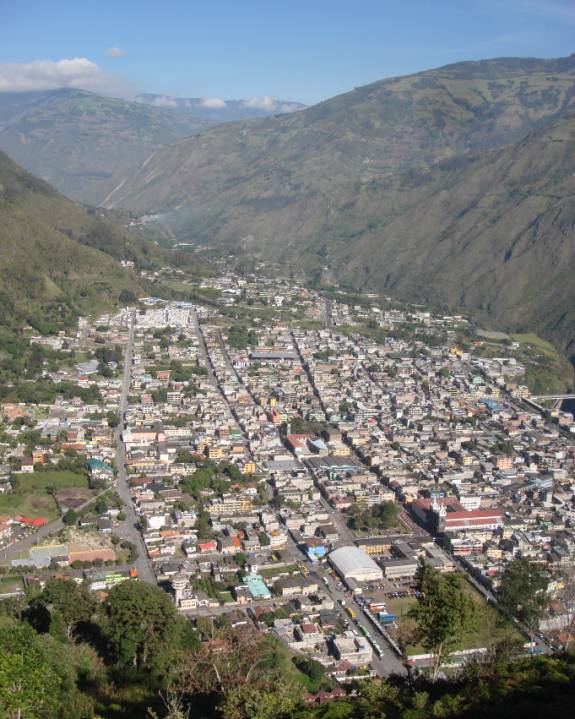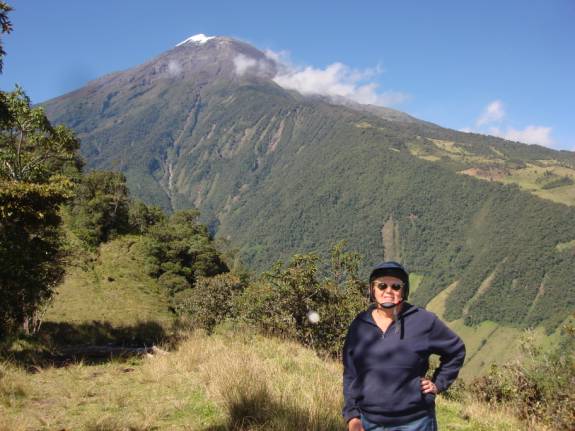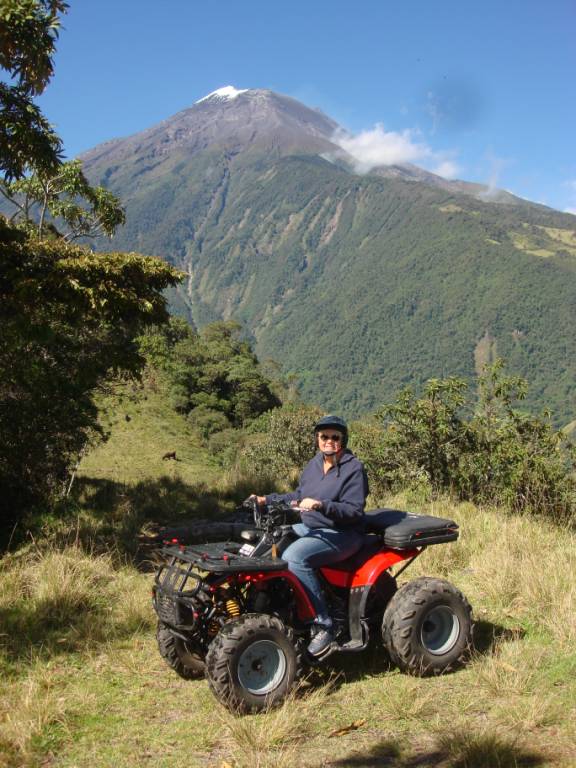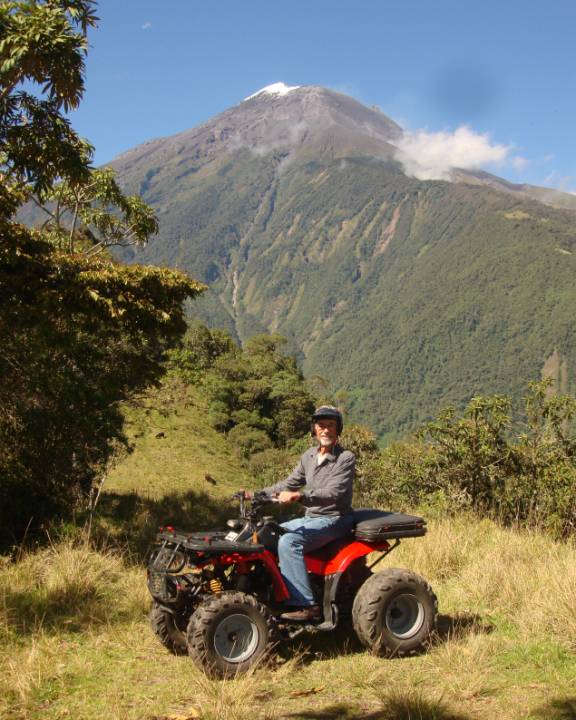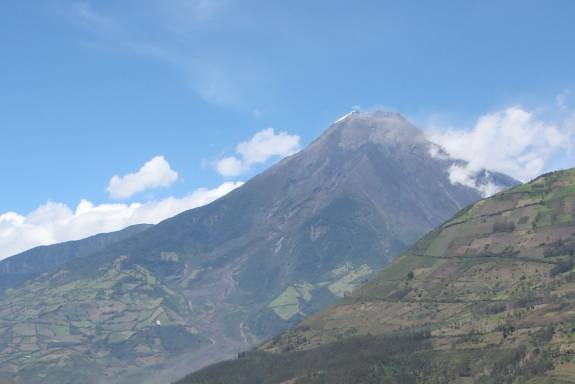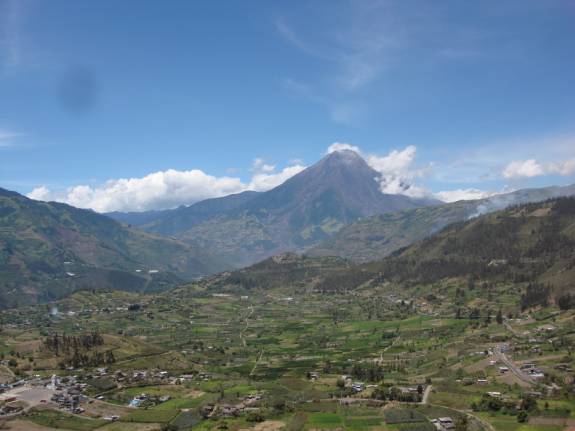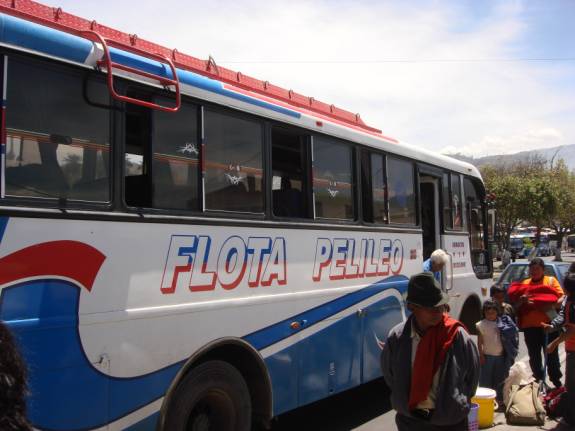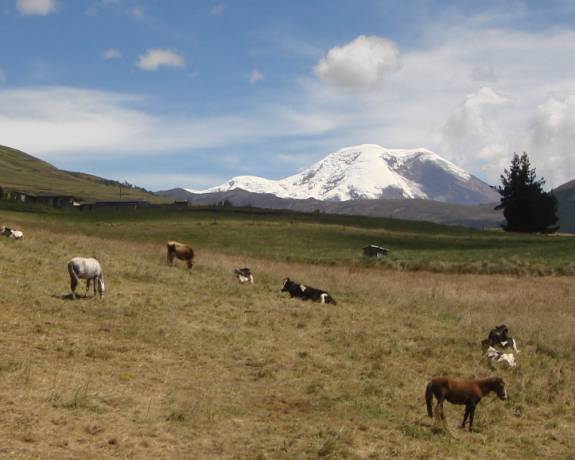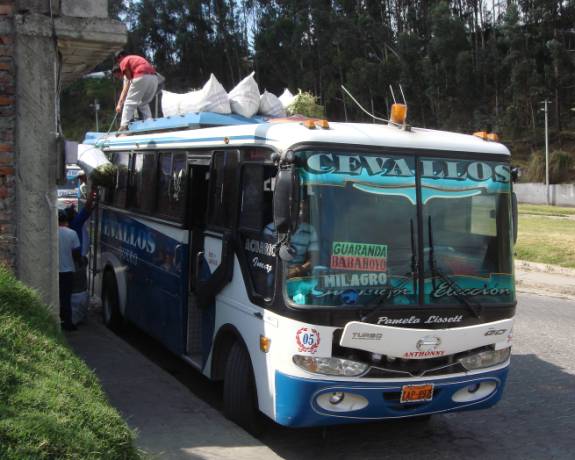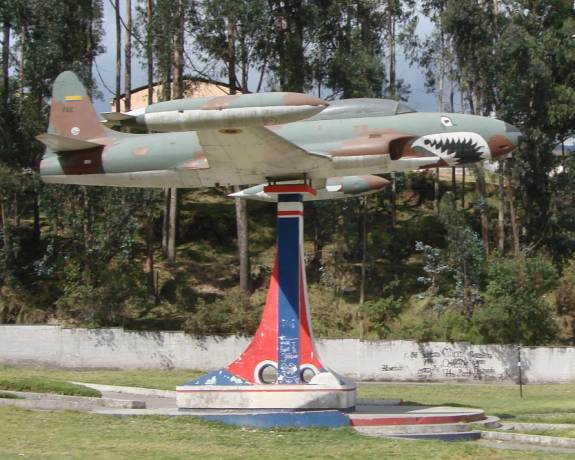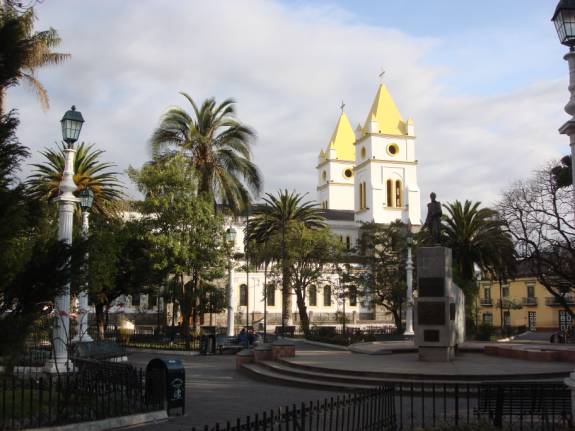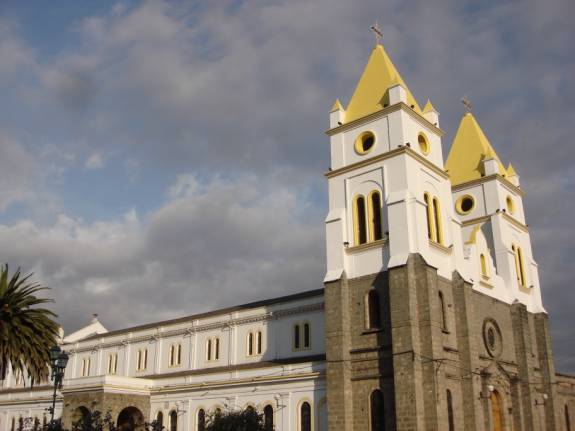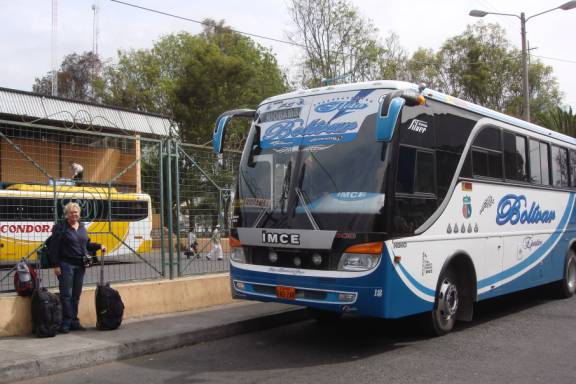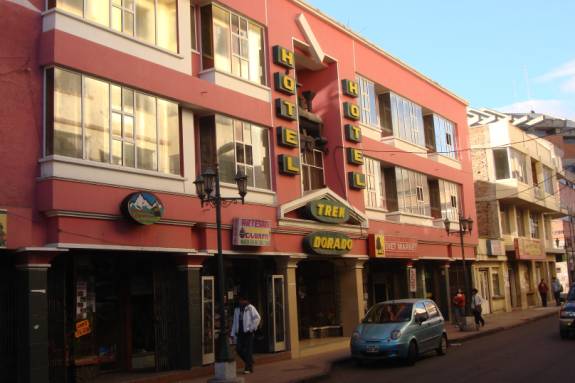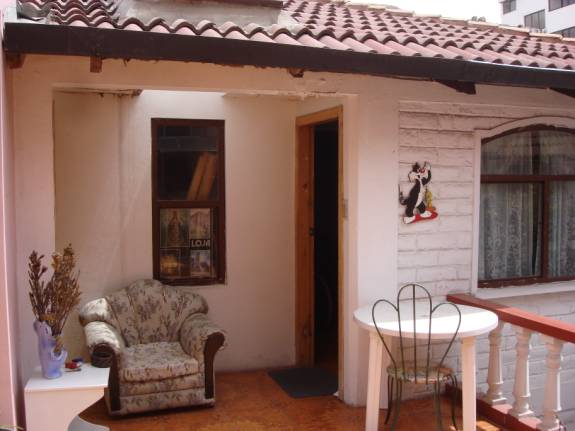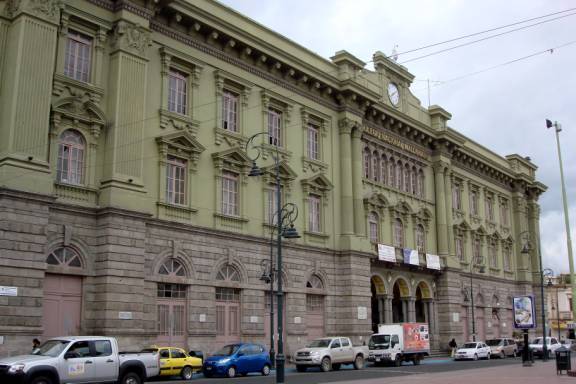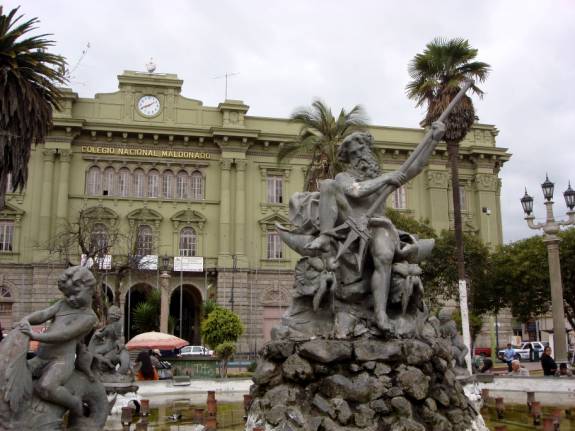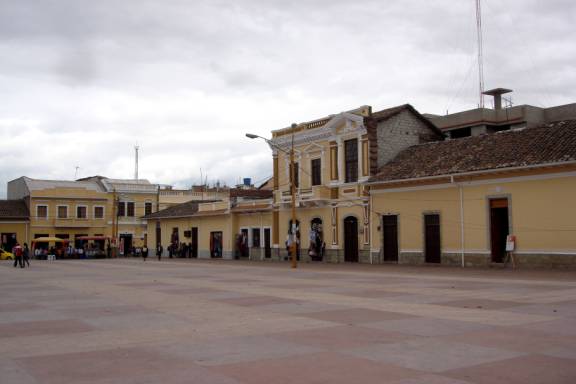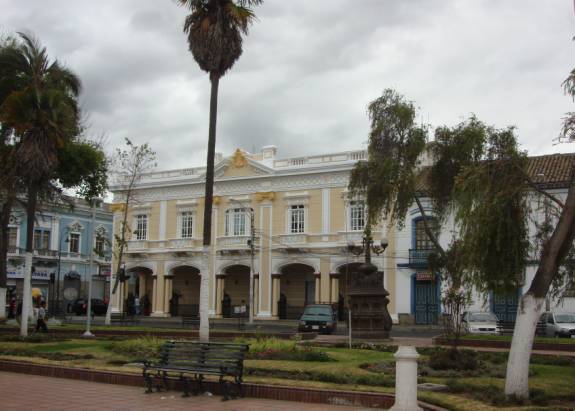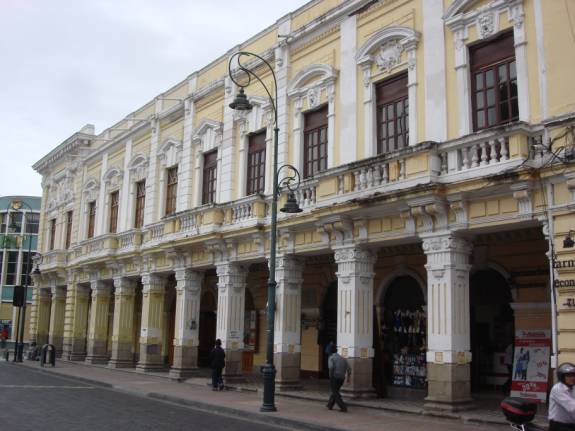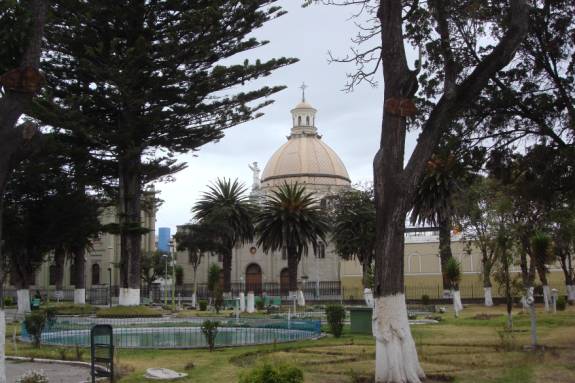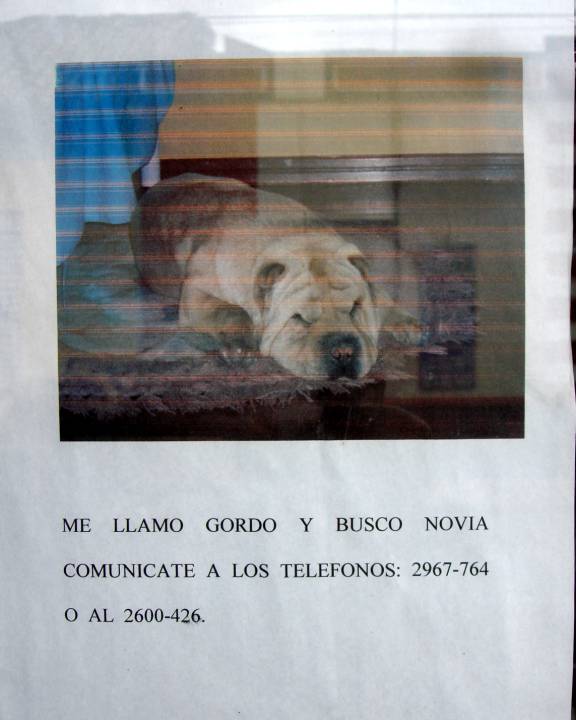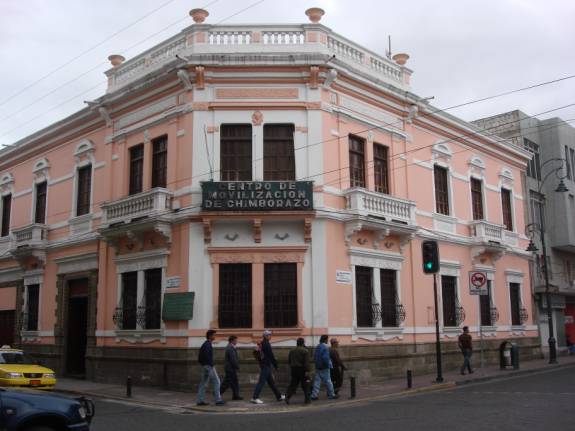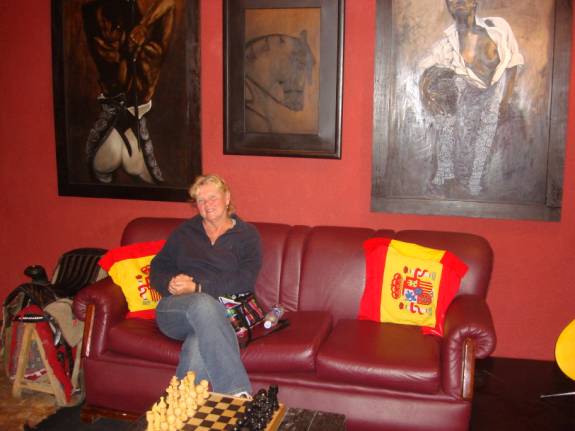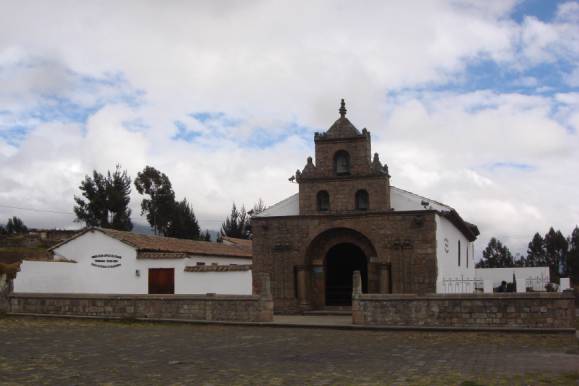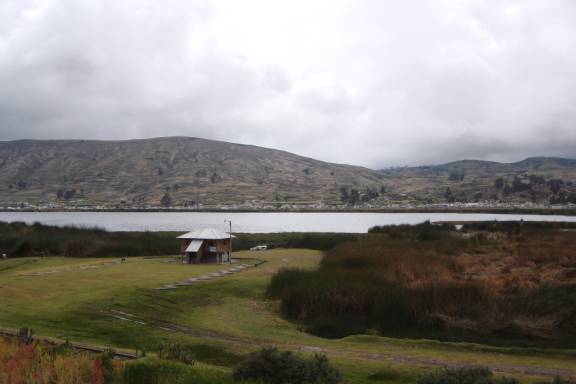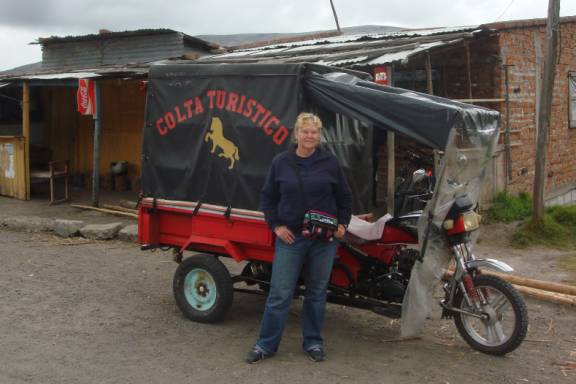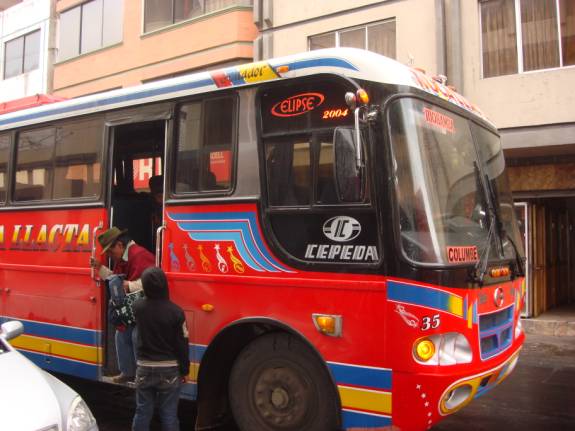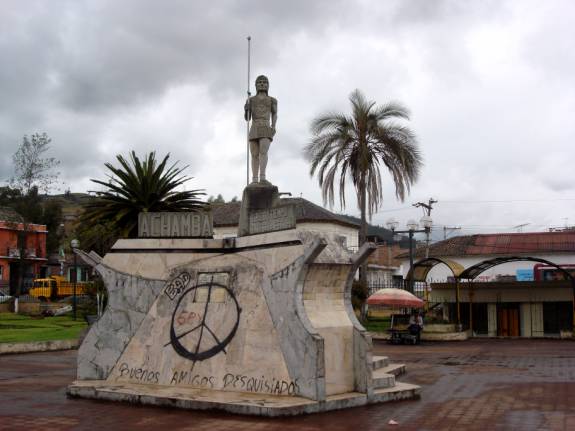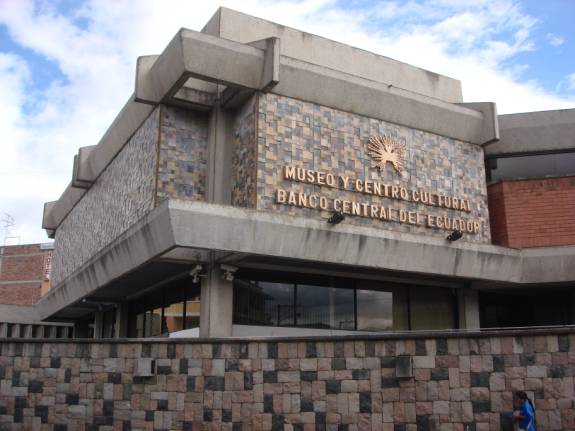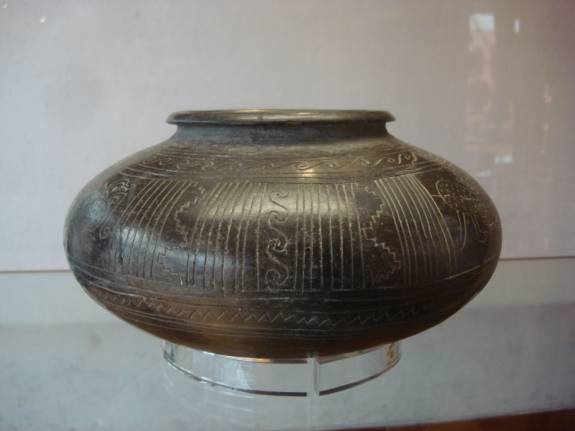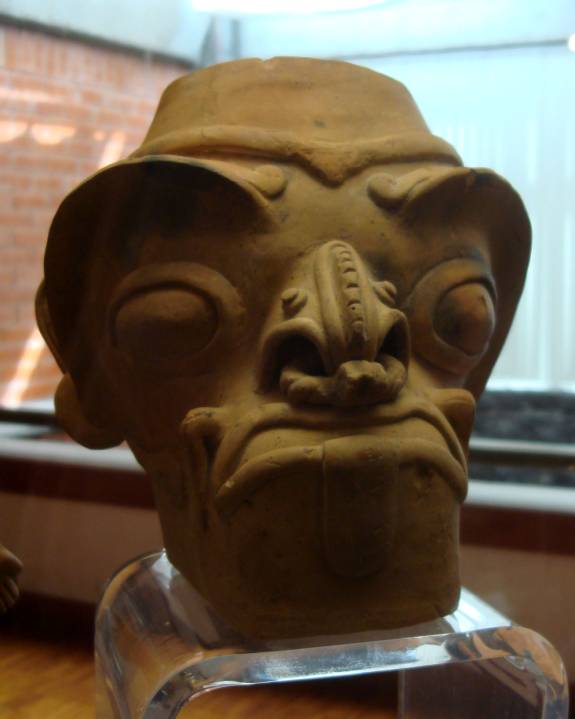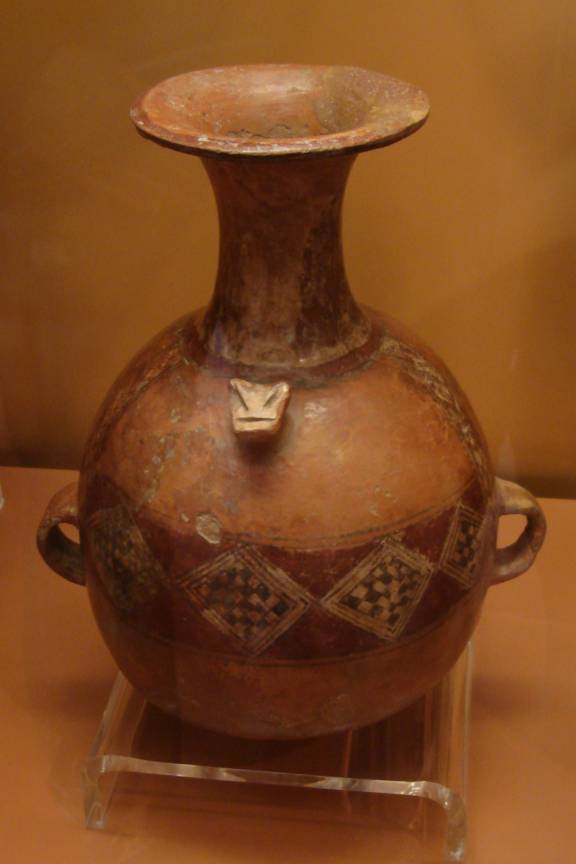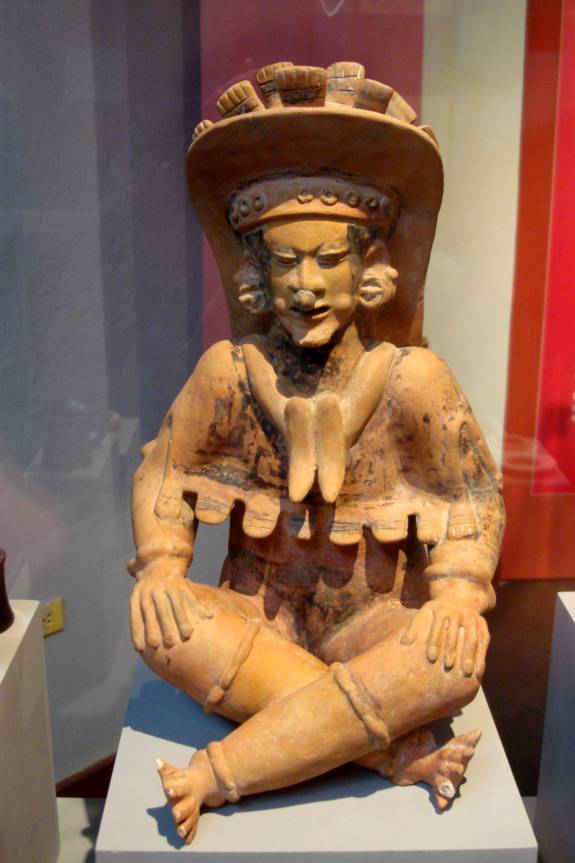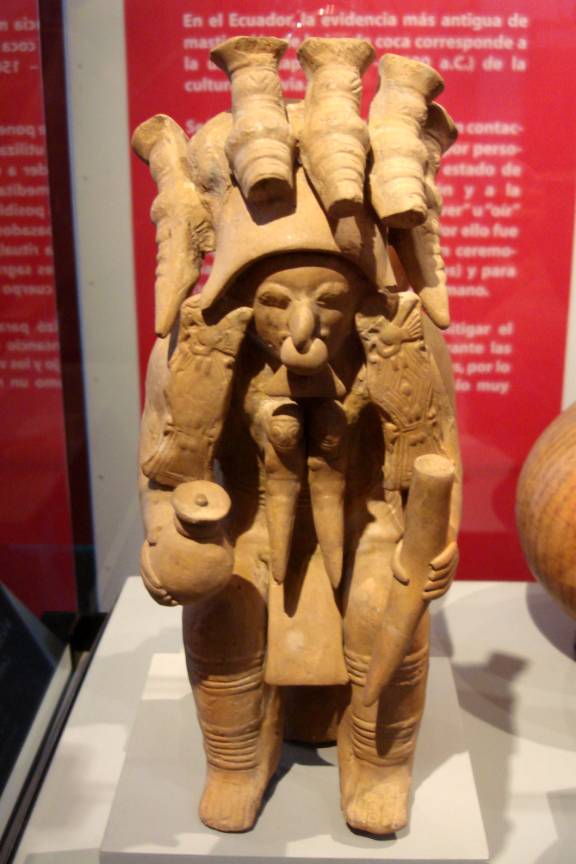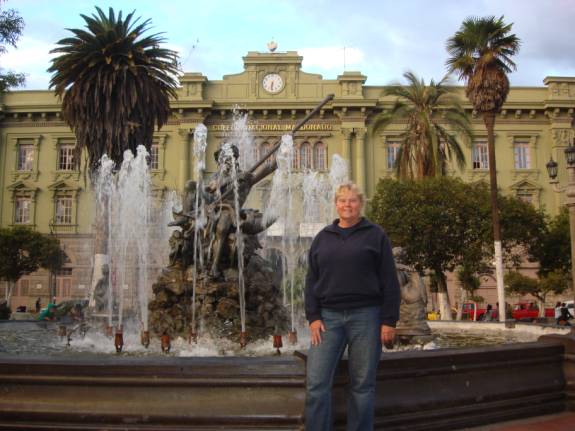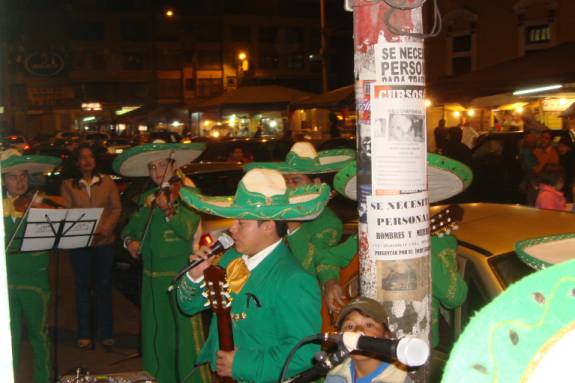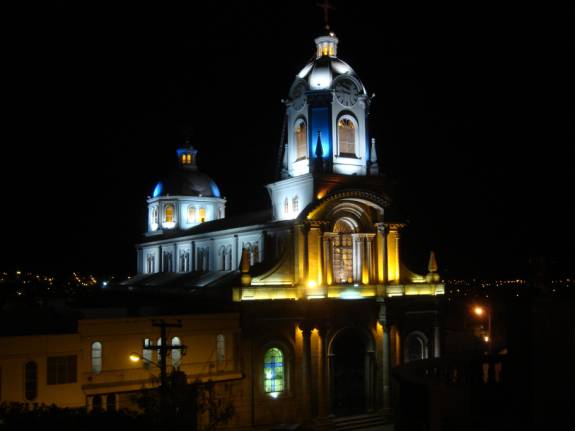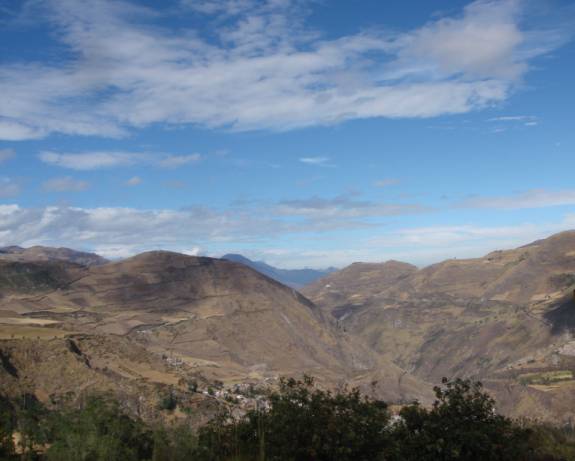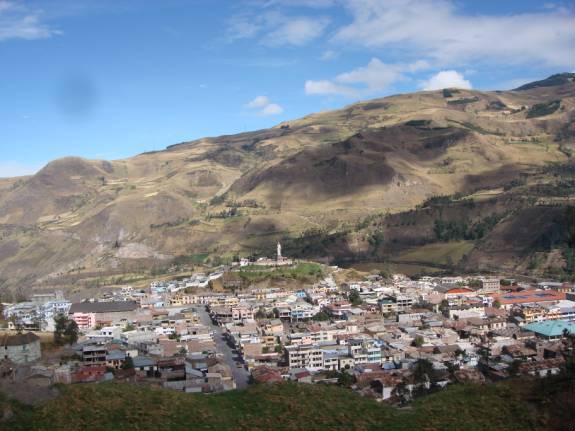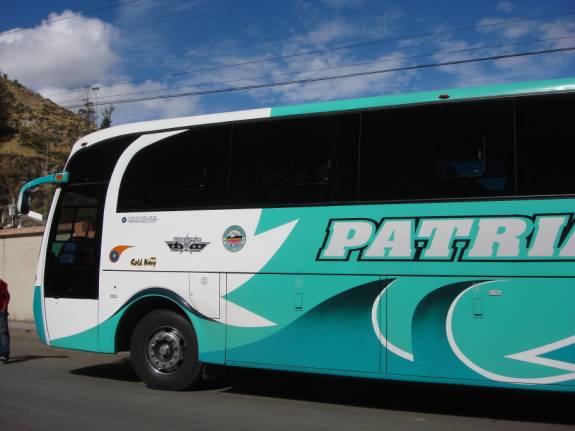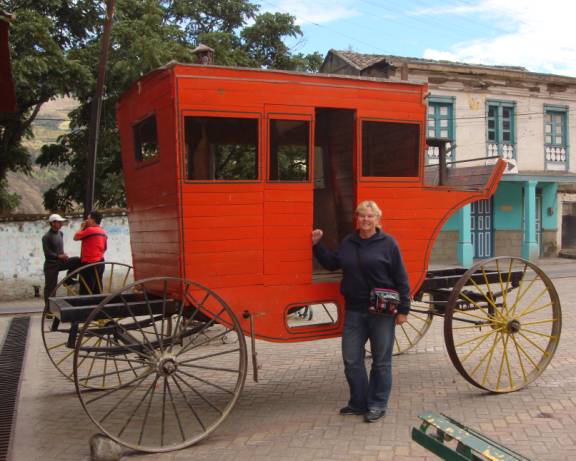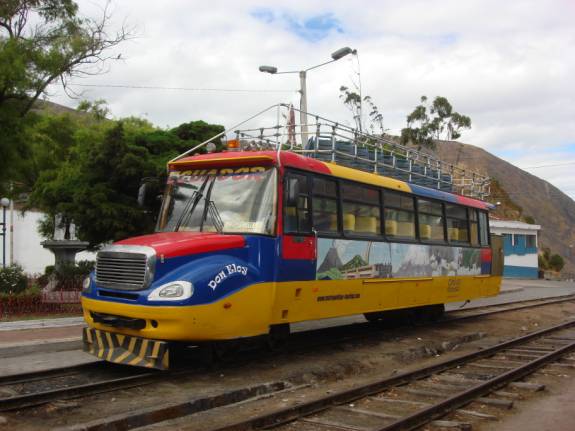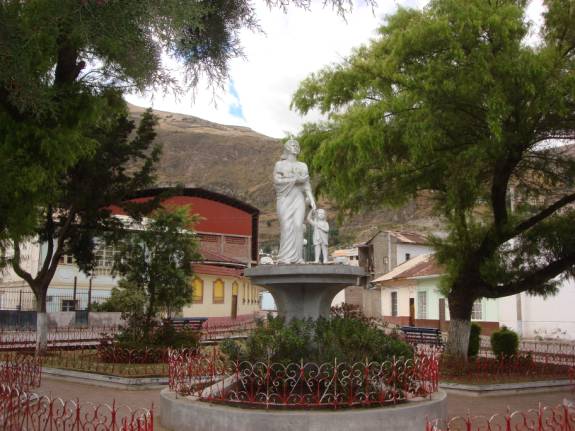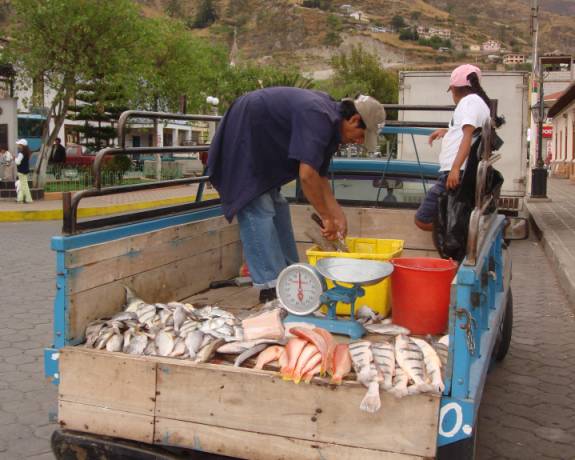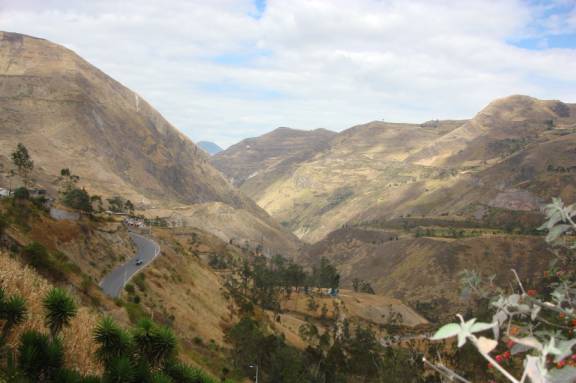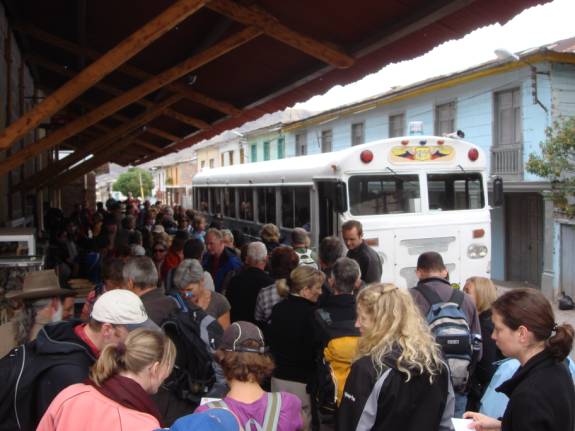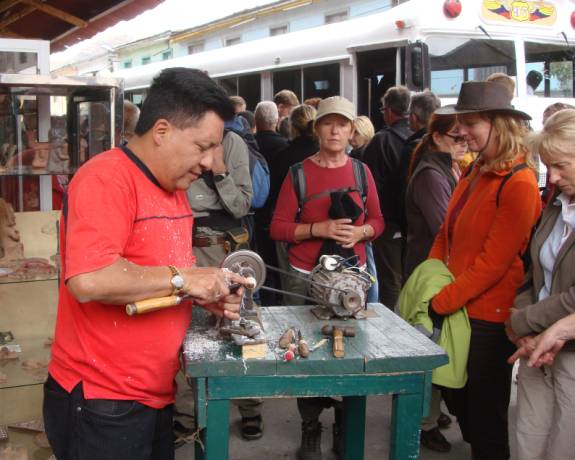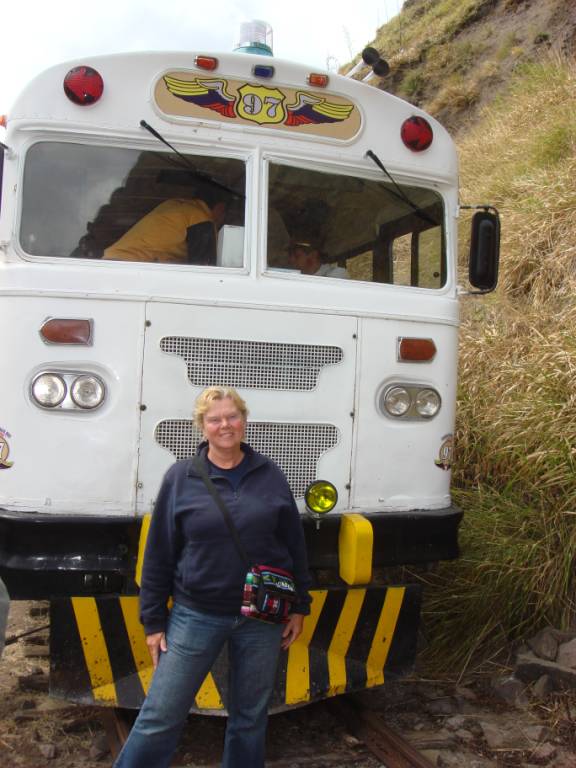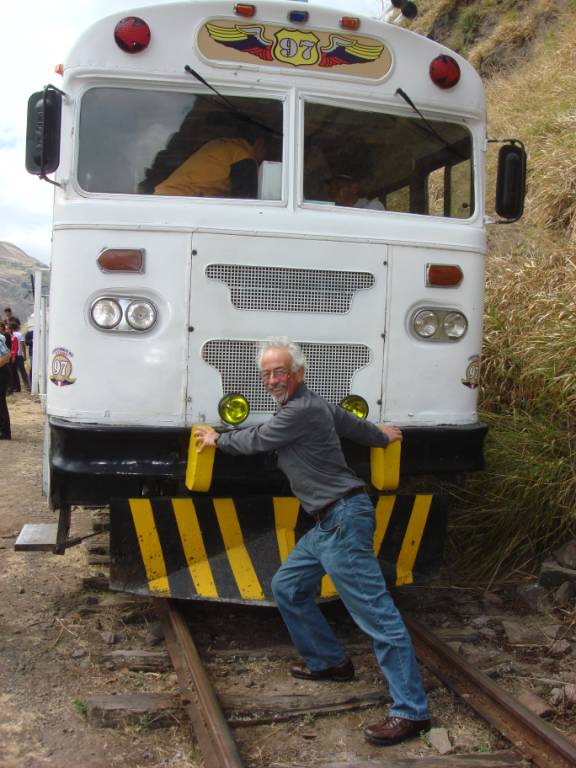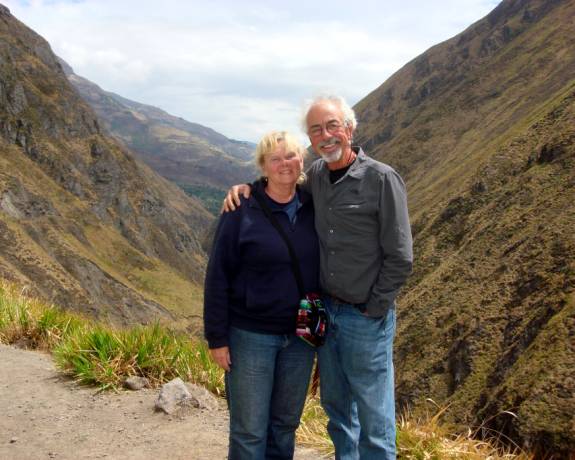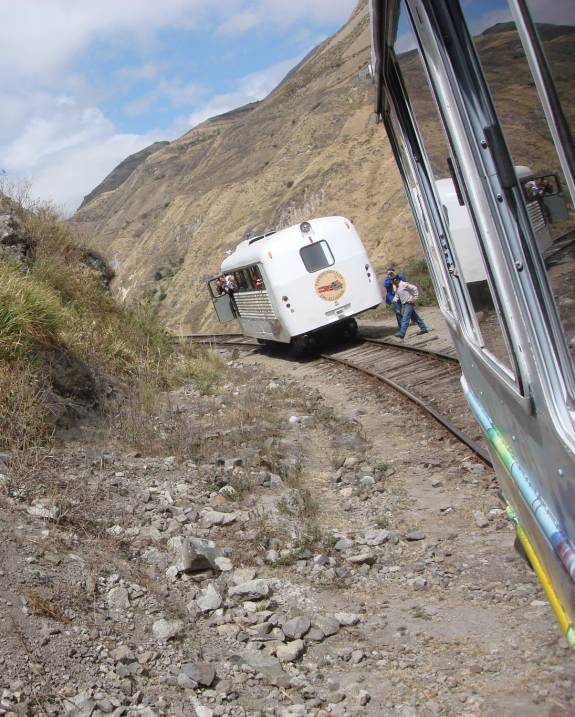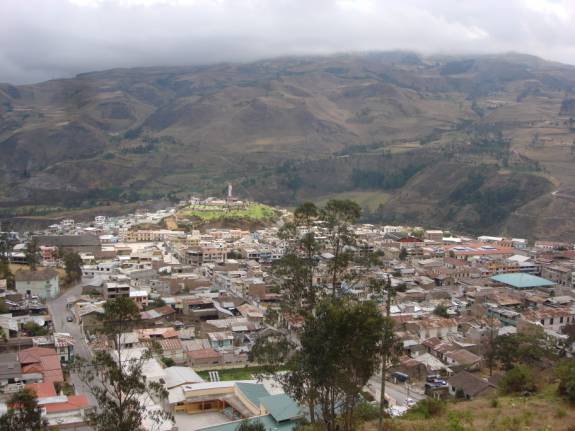|
|
|
|
Site Index:
|
UPDATE#30 08/16 thru 08/19
Howdy
Everybody, The adventures
of 2006, 2007, 2008, and 2009 through 08/15/09 have been published on the
website. We continue with the
latest edition. UPDATE
2009 #30 08/16/09 thru 08/19/09 At last update,
we were in Baños
and enjoying this wonderful location. 08/16/09
SUNDAY BAÑOS
to GUARANDA, ECUADOR HAPPY
BIRTHDAY TO MY SISTER, DONNA PRATT
Judy and I have found the town
of Baños, Ecuador
to be an exciting and adventurous place to enjoy a variety of fun activities.
This morning, the weather was absolutely clear and perfect in the Pastaza
Valley. We returned to Alexander
Tours where they rent “Quadrones”
(4-wheelers). For a bargained rate
of $14 for a 2-hour rental, we headed out to get a better view of the illusive
Tungurahua Volcano. Except
for a quick glance, the huge volcano has been shrouded in the clouds, hiding
until today.
The steepness of the
mountain roads and trails would have been too aggressive for any other kind of
vehicle. We probably should have
had two “quadrones”, but we were okay on the one.
From a mirador,
the view down to Baños
was exceptional.
The road turned to dirt road
before becoming a rutty trail.
The massive, snowcapped
volcano, Volcán Tungurahua,
rises out of the valley to a height of 16,480 feet above sea level.
Tungurahua means “throat
of fire” in the native Quechua language.
It is one of the most active volcanoes in Ecuador.
Although
Tungurahua had been quiet since early in the 20th Century, volcanic
activity restarted in 1999 and there have been major eruptions in 2006 and 2008.
During our visit, there was no visible activity, however, recent reports
indicate that there has since been an eruption on January 12, 2010 that spewed
significant amounts of ash and lava. Fortunately, no lives were lost and the
damage appears to be confined to the agricultural sectors as a result of ash
residues.
Judy on the 4-wheeler ATV…
Fred on the 4-wheeler ATV…
It was a bit underpowered for two riders and was equipped with a
centrifugal clutch.
The views had been magnificent
and the ride was a lot of fun. We
picked up our travel bags from the Hostal Grand Rio about 11am and walked to the
bus terminal. An 11:30am bus had us
headed toward the city of Ambato.
From the bus, the view
of the Volcán
Tungurahua was awesome. From this
angle, we could clearly see the cauldron.
The “Flota Pelileo” bus
took us as far as Ambato, where we changed to the Cevallos Bus Lines for their
1pm bus headed for the town of
Guaranda.
The rural route winds through
the “Avenue of the Volcanoes”. Spectacular
view of many of Ecuador’s most impressive volcanoes could be seen from the
bus.
The
most impressive volcano in Ecuador is the
Volcán Chimborazo. The
inactive Chimborazo is Ecuador's highest summit. The last eruption is thought to
have occurred more than a thousand years ago.
The summit of Chimborazo is regarded as that point on Earth furthest from
the geometric center of our planet, estimated to be a distance of 3,967.1 miles.
Another inactive mountain along
the “Avenue of the Volcanoes”, Volcan Carihuairazo looms to 16,463 feet
above sea level. If you are
traveling from the north, try to sit on the left side of the bus for the best
views. Try to plan your trip early
enough so that the afternoon clouds have not settled in to block your views.
At about 3pm, our bus dropped
us at a major intersection on the outskirts of the town of Guaranda.
In the adjacent park, the
monument of a fighter plane was perched on its mount.
The town was totally tranquil
and there were only a few people around the central park area.
The twin spires of the
Cathedral were painted with an unusual and distinctive coloration.
While Judy sat on some steps of
a closed shop, I went in search of accommodations.
The side streets were rather steep and it was easier to wait there than
tote our bags around. After
checking out several, I selected the nearby Hostal Balcones
Cuenceños
for the bargained rate of $12/night. It
was nothing fancy, but simply clean and fairly comfortable with a private
bathroom.
For the rest
of the afternoon, we strolled around the totally shutdown, totally vacant town
area. Our dinner was pretty good at
Pizza Buen Giorno on the main plaza street.
The fare was Italian and we were the only patrons in the restaurant.
The blue lights of the Cathedral made the spires glow under the night
sky.
As you might guess, bedtime
came fairly early tonight. 08/17/09
MONDAY GUARANDA to
RIOBAMBA
The decision was made last
night to continue our journey to Riobamba this morning.
A taxi at 7am took us to the central bus terminal.
Buying tickets on the Buses Bolivar, we were on our way at 7:45am.
Again, the left side seats offered the best views of the massive
Volcán Chimborazo. Fortunately,
the early departure offered initial views that were fantastic, but the clouds
were already beginning to settle in even before we were out of sight of the
snowcapped peak.
We arrived at the Riobamba
Terminal Terrestre at
9:45am.
Our main goal and purpose for
visiting this town was to take the famous, scenic train ride to the “Nariz
del Diablo” (Devil’s Nose). Our
first stop at the train station was a bit disappointing because they were
completely sold out from Riobamba for the next week or more.
Fortunately, we were able to make advanced reservations for the most
important section of the trip departing from the city of
Alausí on Wednesday afternoon.
The helpful gal at the train
station recommended the Hotel Tren Dorado for a comfortable and economical
choice for the next few days.
All of the rooms have unique
names instead of numbers. Our
quiet, corner room carried the name,
Capricornio.
Being Monday, we had several
days ahead of us to explore the city and its surrounds.
Many of the buildings have an impressive air.
The plaza fountains and
Colegio Nacional Maldonado (Maldonado National College)…
We walked many miles through
the streets of Riobamba, viewing many of the impressive sights.
There are lots of major and
minor plazas surrounded by some wonderful, Spanish Colonial architecture.
The most frequent mode of
transportation for the area indigenous natives is by very crowded trucks.
I was a bit surprised to see all of these guys smoking cigarettes.
I got a real kick out of this
sign seen in a storefront window. Translated,
it said, “MY NAME IS GORDO (fat boy) AND I AM LOOKING FOR A GIRLFRIEND”.
The phone number followed. My
good friend, Joe Fugate in San Antonio, has a Sharpee dog.
Unfortunately, “Dude” is a male; else he might have a Latin lover…
Judging by the sign, this
building is where young people can volunteer and sign up for military service.
Near the central railroad
station, we had lunch at La
Fogata restaurant. We later
returned there for dinner too. The
food was excellent and the prices reasonable.
In the evening, we found a
wonderful little art café serving excellent coffee.
We enjoyed talking with the young owner that had lived in California.
He made some recommendations for places to visit locally.
08/18/09
TUESDAY RIOBAMBA,
ECUADOR
The Hotel Tren Dorado offers a
breakfast buffet for $3pp if you pay by the evening before. We took advantage for a very good breakfast plan that
included items from the kitchen that were being cooked to order.
Near the shores of Laguna de
Colta, the
Balbanera Church stands as the
oldest, Spanish Catholic church in Ecuador.
The original building was destroyed in the severe earthquakes of 1797.
The area around the lake is home to one of the largest populations of indigenous
natives in Ecuador.
We had walked for many miles
around the rural perimeter of the lake. It
was quiet, peaceful farming land with little to see. At this time, the lake levels were very low.
The information from the art café owner led us to believe that it would
be an active and exciting day trip. Being
neither the weekend nor holiday, the area was nearly desolate except for a few
native indigenous folks. We
felt fortunate when this MotoTaxi/MotoTruck passed by.
We flagged him down for a ride to the main highway.
One of many passing buses
dropped us in Riobamba center.
Seeking a more exciting
opportunity, we decided to visit Chambo. We
were told that we could rent horses at a recreation area called “La Pampa”.
When our bus dropped us off in Chambo center, we were told that the only
way to the park was by taxi.
When we got there, we found out
that horses are only available on the weekends and that the park was basically
closed. Oh well… what the heck…
Fortunately, one of
only a few buses was passing by going to the center and then on to Riobamba.
We stayed close to the bus during the 20-minute stop in Chambo center.
Back in Riobamba, we visited
the museum and cultural center. We
were the only visitors and the guard would turn-on and turn-off the lights as we
changed exhibit rooms.
The nicely displayed artifacts
covered Pre-Inca, Inca, and Post-Spanish Conquest periods…
This time, the fountain was
squirting and spurting in vertical harmony…
It appeared to be a birthday
celebration of sorts. It was
unusual to see Mexican style mariachis performing in South America.
It was fairly late when we
walked up a hill to see the illuminated cathedral.
I can’t say that I was very comfortable walking around the deserted
streets. It was a beautiful sight
and there were a few families visiting in the adjacent park area.
08/19/09
WEDNESDAY RIOBAMBA to ALAUSI
to INCAPIRCA, EC
Breakfast was served again in
the Rainforest Café of the Hotel Tren Dorado.
From there, a taxi took us to the main bus terminal.
Having been unable to
secure reservations for the whole train ride from Riobamba, we took an 8:30am
bus for the 2-hour trip to
Alausí, the town where the train makes its steep descent into the canyon
at the Nariz del Diablo (Devil’s Nose). As
it turned out, this was probably better anyway, since the bus follows pretty
much the same route.
The bus dropped us off within
an easy walk downhill to the center in the mountains.
A huge Christian statue dominates a hill mound overlooking the community.
The bus of the Patria Line was
nearly new and very comfortable.
An old stagecoach serves as a
reminder of those days when travel was much more difficult and uncomfortable.
There are only several trains
per week that travel between Riobamba and
Alausí, however, there are a dozen or so scheduled runs along the
continuing section of the Nariz del Diablo.
Using this rather strange contraption that looks more like a bus than a
train, they make frequent runs back and forth over the most interesting and
scenic portion of the route.
In years past, passengers could
ride atop the regular train boxcars for some spectacular viewing.
Because of an accident where several reckless tourists were decapitated,
the regular line banned roof-riding recently.
Dormant on a side track, this colorful train, advertising an exclusive
tourist company, may still offer that thrill, but we were unable to gather any
information about it. I think it is
probably only available for special charter service at exorbitant rates.
A town plaza with a mother and
child statue…
This is the second, ordinary
train, operating on the same route, by
Ferrocarriles Del Ecuador. It
has a somewhat different body design and, like its sister, it has no rooftop
platform.
Having several hours before our
ticket time, we roamed around the town. This
independent vendor was selling fresh fish from the back of his truck.
A close-up of the Monument
to Saint Peter (Monumento a San Pedro), the patron saint of the city, high
above the hilltop mound…
A valley view from the town
center…
Hoards of ticketed passengers
waited for their turn to board. Many
of them arrived in large, organized tour groups.
Predominantly, they are European tourists.
An entrepreneurial artisan was
fascinating the travelers with his craft. Using
a special type of nut that grows inside a tree root, he was turning out
figurines on a small lathe. His
work was excellent and I negotiated with him to buy a small “frog”.
My wonderful daughter-in-law, Lisa, collects frogs and I think she’ll
love this one. His workmanship was
clever and unique. I’ve not seen
anything like it before.
Alausí…
Finally, it was our turn to
board at 1pm. There was some small
confusion when two passengers had the same seat numbers.
Somehow, the company had made an error and one person wasn’t able to
take the ride. As you might
imagine, he was rather disgruntled.
Rail construction work began in
1899 from the coast at
Guayaquil. The tracks
zigzagged up the steep incline to
Alausí in 1902 and continued on to reach Quito by 1908.
The train-bus began its steep
descent through the twists and turns of the Nariz Del Diablo.
Several stops along the way
provided photo opportunities…
You might mistake this as some
Herculean effort by Superman, but I think NOT…
Our LOVE is as high as the
mountains and as deep as the valleys…
Deep in the valley below, the
Sibambe train station appears to be under some major reconstruction efforts.
Formerly, it was a waypoint for the continuation to the coast.
The Devil's Nose segment is so steep that the train has to reverse
itself, through a series of switchbacks, to negotiate the 1-in-18 gradients that
yield a vertical rise of approximately 2,625 feet into the Andean Mountain
range. In the early 1900’s, it
was considered a phenomenal feat of railway engineering.
The driver’s station is
simple, yet functional…
At a turn-around, the
Auto-Ferro (rail bus) had reached the end of the current line and prepared to
make the upward return trip.
As the passengers on our train
waited our turn for the tracks, the sister Ferro-Bus was making its descent from
above.
Mid way, on a switchback
siding, the two rail buses shared a track to facilitate their passing.
With the train ride completed,
our next destination was the village of
Incapirca. A taxi took us up
the steep hill to the main highway and an intersection where we waited for a
bus. The locals had told us that we
might have to wait 20 minutes or so. In
actuality, that stretched into an hour. The
view from the hill was nice but we were becoming inpatient to get moving.
In many of these rural areas,
bus travel is more frequent in the morning and early afternoon. Such was the case here and we boarded the first bus to come
along. The guy collecting the fares
tried desperately to extract a much higher tariff than normal.
I guess he is used to taking advantage of the tourists that have been
visiting the train ride. Of course, I argued. In
cahoots with the driver, he came back with a bit lower fare amount.
A local man on the bus secretly signaled me with three fingers indicating
the normal fare. After arguing a
bit more, I finally got him to accept an amount just a little bit higher than
normal. I would have gotten off the
bus except it was beginning to drizzle outside and I figured it might be a while
before we could get another bus. Sometimes,
you just have to accept that you are a tourist target.
In the future, we will probably avoid the green and white buses marked
“Sucre Express”. Oh well, no
big deal and no big loss…
By the time we got to
the town of El Tambo, it was already dark and the area was nearly deserted.
I had hoped to find a local bus there but there were only a couple of
taxis available at this late hour. We
negotiated for the trip along the rough roads to our destination at Incapirca.
The village was dark and nothing was open. Our driver suggested the local Hostal Huasipungo to provided
us with a rather humble, but adequate, room for the night.
The pleasant woman opened the kitchen to prepare something for us to eat.
Being quite tired from a busy day, we rested well.
Tomorrow morning, we
will visit the famous Incapirca ruins. CONTINUING
UPDATES ARE IN PROGRESS… WATCH FOR THEM, COMING SOON… POST SCRIPT:
We sincerely hope that you will
review the previous years of compilations to give context to the current
editions. Please let us know if you
have any special suggestions and thoughts.
REMEMBER:
The website is now fully active and you can visit it at any time.
You can also review any of the previous logs from the years 2006, 2007,
or 2008 and learn more about the crew and their many adventures.
Enjoy. ATTENTION:
SPECIAL NOTE:
You may contact us via
email anytime. Thanks
for allowing us to share our life and adventures with you. Lotsa
Luv, Fred
Reed and Judy Law AMARSE MT40 "AMARSE"
is
pronounced "AM-ARE-SAY".
Our website is: www.amarse.net
.
|
|
Fred H. Reed |
www.amarse.net © 2006 2007 2008 2009 2010 2011 |

